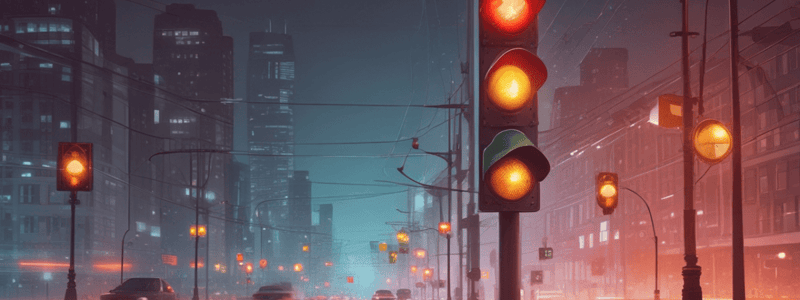Podcast
Questions and Answers
What is the priority at pedestrian crossings in the UK?
What is the priority at pedestrian crossings in the UK?
- Turning traffic has priority over pedestrians
- Pedestrians have priority over turning traffic (correct)
- Cyclists have priority over pedestrians
- Vehicles have priority over pedestrians and cyclists
What is the purpose of the red/amber phase in traffic signals?
What is the purpose of the red/amber phase in traffic signals?
- To indicate that traffic lights are about to turn green (correct)
- To indicate that pedestrians can cross
- To indicate that traffic lights are about to turn red
- To indicate that cyclists can cross
What is the sequence of traffic signals in the UK?
What is the sequence of traffic signals in the UK?
- Red, green, amber, red
- Green, amber, red, red/amber
- Red, red/amber, green, amber (correct)
- Amber, red, green, red/amber
What is the purpose of a Toucan crossing?
What is the purpose of a Toucan crossing?
What type of junction separates pedestrian and cyclist crossings from the main traffic flow?
What type of junction separates pedestrian and cyclist crossings from the main traffic flow?
What type of pedestrian crossing is marked by black and white stripes?
What type of pedestrian crossing is marked by black and white stripes?
What type of crossing allows pedestrians to activate the crossing signal?
What type of crossing allows pedestrians to activate the crossing signal?
What is the purpose of traffic signals in the UK?
What is the purpose of traffic signals in the UK?
Flashcards are hidden until you start studying
Study Notes
Traffic Crossing Sequences in the UK
General Rules
- Pedestrian crossings have priority over turning traffic
- Traffic signals are designed to minimize conflicts between pedestrians, cyclists, and vehicles
Typical Sequence
- Red phase: All traffic signals are red, and all traffic must come to a halt
- Red/amber phase: Signals turn red/amber, indicating to drivers that the lights are about to turn green
- Green phase: Signals turn green, allowing traffic to proceed
- Amber phase: Signals turn amber, indicating to drivers to prepare to stop
- Red phase: Signals return to red, and traffic must come to a halt
Pedestrian and Cyclist Crossings
- Pedestrian crossings: Pedestrians are given a green man signal to cross, while traffic is held at a red light
- Cyclist crossings: Cyclists are given a green cycle symbol to cross, while traffic is held at a red light
- Toucan crossings: Shared pedestrian and cyclist crossings, marked by a green cycle symbol and a green man
Signal-Controlled Junctions
- Staggered junctions: Pedestrian and cyclist crossings are separated from the main traffic flow, with each having its own signal phase
- Simultaneous junctions: Pedestrian and cyclist crossings occur at the same time as the main traffic flow, with all traffic signals turning green simultaneously
Other Types of Crossings
- Zebra crossings: Uncontrolled pedestrian crossings marked by black and white stripes, with priority given to pedestrians
- Puffin crossings: Uncontrolled pedestrian crossings with a pedestrian-activated signal, where pedestrians press a button to activate the crossing
- Staggered pedestrian crossings: Pedestrian crossings with separate signals for each direction of traffic, often used at busy junctions
Traffic Crossing Sequences in the UK
General Rules
- Pedestrians have priority over turning traffic at pedestrian crossings
- Traffic signals are designed to minimize conflicts between pedestrians, cyclists, and vehicles
Typical Sequence
- The sequence of traffic signals includes: red, red/amber, green, amber, and red again
- During the red phase, all traffic must come to a halt
- During the red/amber phase, drivers are warned that the lights are about to turn green
- During the green phase, traffic is allowed to proceed
- During the amber phase, drivers are warned to prepare to stop
- The sequence then returns to the red phase, and traffic must come to a halt
Pedestrian and Cyclist Crossings
Pedestrian Crossings
- Pedestrians are given a green man signal to cross
- Traffic is held at a red light to allow pedestrians to cross
Cyclist Crossings
- Cyclists are given a green cycle symbol to cross
- Traffic is held at a red light to allow cyclists to cross
Toucan Crossings
- Shared pedestrian and cyclist crossings
- Marked by a green cycle symbol and a green man
- Pedestrians and cyclists cross together
Signal-Controlled Junctions
Staggered Junctions
- Pedestrian and cyclist crossings are separated from the main traffic flow
- Each has its own signal phase
Simultaneous Junctions
- Pedestrian and cyclist crossings occur at the same time as the main traffic flow
- All traffic signals turn green simultaneously
Other Types of Crossings
Zebra Crossings
- Uncontrolled pedestrian crossings
- Marked by black and white stripes
- Priority is given to pedestrians
Puffin Crossings
- Uncontrolled pedestrian crossings
- Pedestrian-activated signal
- Pedestrians press a button to activate the crossing
Staggered Pedestrian Crossings
- Pedestrian crossings with separate signals for each direction of traffic
- Often used at busy junctions
Studying That Suits You
Use AI to generate personalized quizzes and flashcards to suit your learning preferences.




